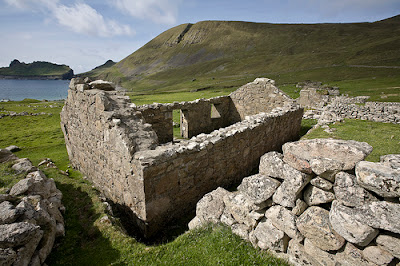Most modern commentators feel that the predominant theme of life on St Kilda was isolation. When Martin Martin visited the islands in 1697, the only means of making the journey was by open boat, which could take several days and nights of rowing and sailing across the ocean and was next to impossible in autumn and winter. In all seasons, waves up to 12 metres (39 ft) high lash the beach of Village Bay, and even on calmer days landing on the slippery rocks can be hazardous. Separated by distance and weather, the natives knew little of mainland and international politics. After the Battle of Culloden in 1746, it was rumoured that Prince Charles Edward Stuart and some of his senior Jacobite aides had escaped to St Kilda. An expedition was launched, and in due course British soldiers were ferried ashore to Hirta. They found a deserted village, as the St Kildans, fearing pirates, had fled to caves to the west. When the St Kildans were persuaded to come down, the soldiers discovered that the isolated natives knew nothing of the prince and had never heard of King George II either.
In the eighteenth century the island had about 100 inhabitants. In 1851, 36 emigrated to Australia, a demographic blow from which the island never recovered. In the later nineteenth century, tourist boats began to call regularly on the island, but they brought with them diseases to which the isolated islanders had no resistance, and infant mortality on the island rose to near 80 percent. By 1930, only 36 islanders remained, and they asked to be evacuated.
Even in the late 19th century, the islanders could communicate with the rest of the world only by lighting a bonfire on the summit of Conachair and hoping a passing ship might see it, or by using the "St Kilda mailboat". The mailboat was the invention of John Sands, who visited in 1877. During his stay, a shipwreck left nine Austrian sailors marooned there, and by February supplies were running low. Sands attached a message to a lifebuoy salvaged from the Peti Dubrovacki and threw it into the sea. Nine days later it was picked up in Birsay, Orkney and a rescue was arranged. The St Kildans, building on this idea, fashioned a piece of wood into the shape of a boat, attached it to a bladder made of sheepskin, and placed in it a small bottle or tin containing a message. [Above] Launched when the wind came from the north-west, two-thirds of the messages were later found on the west coast of Scotland or, less conveniently, in Norway.
Another significant feature of St Kildan life was the diet. The islanders kept sheep and a few cattle and were able to grow a limited amount of food crops such as barley and potatoes on the better-drained land in Village Bay, and in many ways the islands can be seen as large mixed farm. . . . They generally eschewed fishing because of the heavy seas and unpredictable weather. The mainstay of their food supplies was the profusion of island birds, especially gannet and fulmar. These they harvested as eggs and young birds and ate both fresh and cured. Adult puffins were also caught by the use of fowling rods. . . . An excavation of the Taigh an t-Sithiche (the "house of the faeries", above) in 1877 by Sands unearthed the remains of gannet, sheep, cattle and limpets amidst various stone tools. The building is between 1,700 and 2,500 years old, which suggests that the St Kildan diet had changed little over the millennia. Indeed the tools were recognised by the St Kildans, who could put names to them as similar devices were still in use.
Now the islands are owned by the National Trust for Scotland and have been designated a UNESCO World Heritage Site. There is a small military post, and biologists and archaeologists frequently visit. But the old village is abandoned, the stone houses empty ruins.











No comments:
Post a Comment